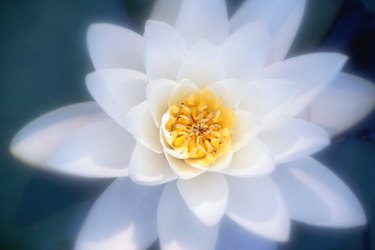
About 25,000 species of plants -- terrestrial and aquatic -- live in and around the Mediterranean Sea. Of these, half are found nowhere else on Earth. The IUCN Red List did a study on 473 of the aquatic plants in the Mediterranean. The organization determined that of these, at least 15 percent are at risk of becoming extinct. Along with threatened native plants, the Mediterranean also has introduced aquatic flora. Pollution, degradation of the sea biome and invasive species all play a part in affecting Mediterranean aquatic plants.
Water Pennywort
Video of the Day
Water pennywort, also called marsh pennywort (Hydrocotyle vulgaris), is an aquatic plant species found in the Mediterranean. Although native to North African and European regions, it is not endemic, or not found exclusively, in the Mediterranean. The 5-inch-wide leaves, shaped like rounded shields, float above the water's surface. Water pennywort blooms to produce inconspicuous white flowers. They are not at risk in the Mediterranean biome.
Video of the Day
White Lotus
White lotus, also called Egyptian white water lily (Nymphaea Lotus), is found in stagnant waters in the Mediterranean region. Native to the Nile River, it has been introduced to the Mediterranean biome. Flower stems branch from floating lily pads at heights of up to 20 inches. Flower blossoms are white, multi-petaled and star-shaped. White lotus is endangered in the Mediterranean.
Water Hyacinth
Water hyacinth (Eichornia crassipes) is an invasive species in the Mediterranean basin originally from South America. According to the IUCN Red List, water hyacinths double their population every two weeks in the Mediterranean. The plant's leathery, long leaves float above the water, preventing sunlight from penetrating, which affects the ecosystem below. Water hyacinth also outcompetes native aquatic plants and interferes with boat traffic. This species produces showy blue-violet blossoms. Six-petaled flowers form an elongated clump or tube on the top portion of the stem.
Neptune Grass
Neptune grass (Posidonia oceanica) is presently only found in the Mediterranean and in the southern waters of Australia. It may be found at depths from 15 to 165 feet. Its ribbon-shaped grass blades slowly grow along horizontal rhizomes to form underwater meadows. Unfortunately, it is being severely outcompeted by Caulerpa taxifolia, an introduced aquatic green alga. Caulerpa taxifolia was introduced from the Caribbean and has quickly become prolific in the Mediterranean. Its feathery, green blades form invasive masses. According to the Center for Aquatic and Invasive Plants, in areas it establishes itself, it is able to kill 45 percent of the Neptune grass population per year.
- Center for Aquatic and Invasive Plants -- University of Florida: Green Alga
- The IUCN Red List: The Mediterranean -- A Biodiversity Hotspot Under Threat
- The IUCN Red List: Aquatic Plants
- Plant of the Week: Hydrocotyle Vulgaris
- Department of Ecology, State of Washington: Non-Native Invasive Freshwater Plants
- Dive Site Directory: Posidonia Oceanica Seagrass Meadows Under Threat